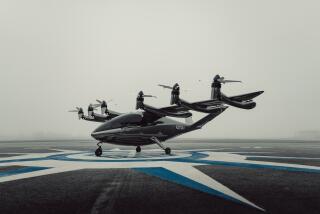COSTA MESA : Owner Gives Wing to His Flying Car
- Share via
Edward Sweeney is no George Jetson. But he’s close.
George could hop into his bubble-car and zip into the sky on his way to work at Spacely Sprockets. Sweeney can jump into his car and zip into the sky too. But converting his 1956 two-seater Aerocar I into an airworthy vehicle requires two people and half an hour to bolt on the fuselage and wings.
Sweeney, 49, is the proud owner of one of the few cars ever built that can go from the freeways to the airways.
The 148-horsepower car-plane is the last of five flying Aerocars built after World War II by a Navy commander who also helped design the first cruise missile. The four others are in museums.
Sweeney took his green and yellow car for a 12-minute flight Tuesday from John Wayne Airport, hoping to persuade engineers attending a national conference on future transportation technology that it’s time to revive the 40-year-old car-plane technology.
“The design ideas that were invented in the 1950s will become the transportation systems of the the 1990s,” said Sweeney, a Daytona Beach, Fla., engineer who said he once turned down a $2-million offer to sell his flying car. The nation’s travelers could fly above congested freeways and the crumbling interstate highway system, he said.
When the wings and airplane body are detached, Sweeney’s car looks pretty much like what it is--a small 1950s car.
His Nevada license plate reads “AEROCAR.”
Engineers attending the Society of Automotive Engineers national conference at the Westin South Coast Plaza said flying cars could be attractive to business travelers who frequently commute several hundred miles. Rather than spending hours driving, a flying car would allow a traveler to drive to the airport, take off and fly to his or her destination, then drive the final few miles.
The idea of getting long-distance commuters off the roads and into the air is nothing new, said Thomas Faulconer, 80, a San Diego engineer who began working on flying cars in 1935. The flying-car idea swept through several aircraft manufacturers just before and after World War II, and died when the postwar aerospace industry collapsed, Faulconer said.
Consolidated Vultee Aircraft Corp., a company that he worked for, built about a dozen flying cars, he said. But the major drawback was that the cars required a bolt-on fuselage and wings that had to be left at the airport. One of the company backers, the founder of Hertz Rent-a-Car, even thought of renting fuselages at the airport, Faulconer said.
Flying-car owners would pull up to the Hertz Rent-A-Wing office before flying to their destination, he said.
Sweeney must also detach his car’s airplane body and wings before hitting the road. The Aerocar’s body can be folded up and towed behind the car.
Some people--such as Branko Sarh, ) a Riverside engineer who attended the conference--envision flying cars as completely self-contained vehicles.
Only a lack of investors keeps the flying cars tethered to the drawing board, he said. If mass-produced, his flying car probably would sell for about $200,000.
Sweeney would not reveal what he paid for his Aerocar, but he considers it “priceless.” He transports the car inside a trailer rather than flying or driving it.
Faulconer believes the price of the cars will always be a practical barrier to their widespread use.
“If anybody hit you or even touched you gently, you’d risk losing a $50,000 tail section,” he said. “And where would you park it? It would be vandalized in minutes.”
More to Read
Inside the business of entertainment
The Wide Shot brings you news, analysis and insights on everything from streaming wars to production — and what it all means for the future.
You may occasionally receive promotional content from the Los Angeles Times.










